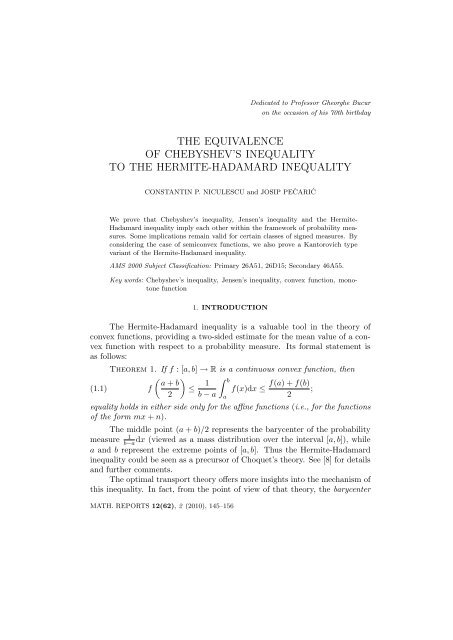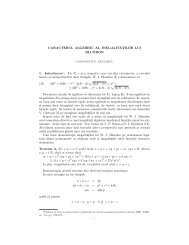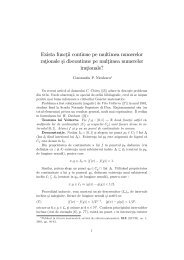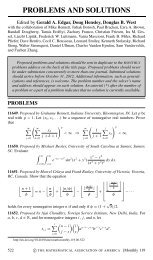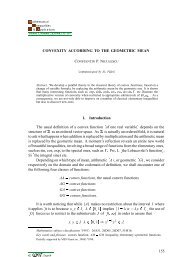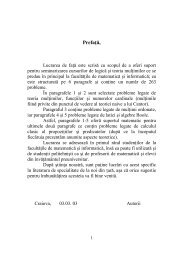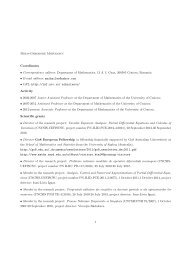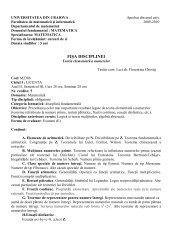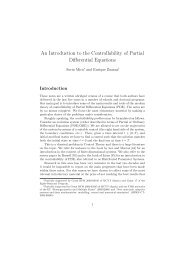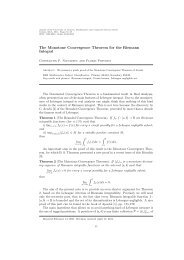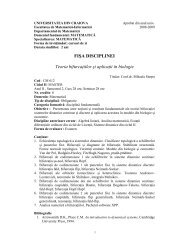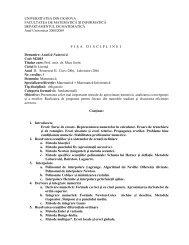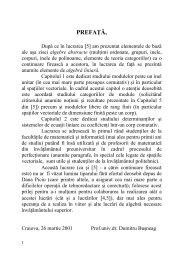the equivalence of chebyshev's inequality to the hermite-hadamard ...
the equivalence of chebyshev's inequality to the hermite-hadamard ...
the equivalence of chebyshev's inequality to the hermite-hadamard ...
Create successful ePaper yourself
Turn your PDF publications into a flip-book with our unique Google optimized e-Paper software.
Dedicated <strong>to</strong> Pr<strong>of</strong>essor Gheorghe Bucur<br />
on <strong>the</strong> occasion <strong>of</strong> his 70th birthday<br />
THE EQUIVALENCE<br />
OF CHEBYSHEV’S INEQUALITY<br />
TO THE HERMITE-HADAMARD INEQUALITY<br />
CONSTANTIN P. NICULESCU and JOSIP PEČARIĆ<br />
We prove that Chebyshev’s <strong>inequality</strong>, Jensen’s <strong>inequality</strong> and <strong>the</strong> Hermite-<br />
Hadamard <strong>inequality</strong> imply each o<strong>the</strong>r within <strong>the</strong> framework <strong>of</strong> probability measures.<br />
Some implications remain valid for certain classes <strong>of</strong> signed measures. By<br />
considering <strong>the</strong> case <strong>of</strong> semiconvex functions, we also prove a Kan<strong>to</strong>rovich type<br />
variant <strong>of</strong> <strong>the</strong> Hermite-Hadamard <strong>inequality</strong>.<br />
AMS 2000 Subject Classification: Primary 26A51, 26D15; Secondary 46A55.<br />
Key words: Chebyshev’s <strong>inequality</strong>, Jensen’s <strong>inequality</strong>, convex function, mono<strong>to</strong>ne<br />
function<br />
1. INTRODUCTION<br />
The Hermite-Hadamard <strong>inequality</strong> is a valuable <strong>to</strong>ol in <strong>the</strong> <strong>the</strong>ory <strong>of</strong><br />
convex functions, providing a two-sided estimate for <strong>the</strong> mean value <strong>of</strong> a convex<br />
function with respect <strong>to</strong> a probability measure. Its formal statement is<br />
as follows:<br />
Theorem 1. If f : [a, b] → R is a continuous convex function, <strong>the</strong>n<br />
( ) a + b<br />
(1.1) f ≤ 1 ∫ b<br />
f(a) + f(b)<br />
f(x)dx ≤ ;<br />
2 b − a<br />
2<br />
a<br />
equality holds in ei<strong>the</strong>r side only for <strong>the</strong> affine functions (i.e., for <strong>the</strong> functions<br />
<strong>of</strong> <strong>the</strong> form mx + n).<br />
The middle point (a + b)/2 represents <strong>the</strong> barycenter <strong>of</strong> <strong>the</strong> probability<br />
1<br />
measure<br />
b−adx (viewed as a mass distribution over <strong>the</strong> interval [a, b]), while<br />
a and b represent <strong>the</strong> extreme points <strong>of</strong> [a, b]. Thus <strong>the</strong> Hermite-Hadamard<br />
<strong>inequality</strong> could be seen as a precursor <strong>of</strong> Choquet’s <strong>the</strong>ory. See [8] for details<br />
and fur<strong>the</strong>r comments.<br />
The optimal transport <strong>the</strong>ory <strong>of</strong>fers more insights in<strong>to</strong> <strong>the</strong> mechanism <strong>of</strong><br />
this <strong>inequality</strong>. In fact, from <strong>the</strong> point <strong>of</strong> view <strong>of</strong> that <strong>the</strong>ory, <strong>the</strong> barycenter<br />
MATH. REPORTS 12(62), 2 (2010), 145–156
146 Constantin P. Niculescu and Josip Pečarić 2<br />
<strong>of</strong> a mass distribution on [a, b], represented by a Borel probability measure µ,<br />
is <strong>the</strong> unique minimizer b µ <strong>of</strong> <strong>the</strong> transportation cost,<br />
C(y) = 1 2<br />
∫ b<br />
a<br />
|x − y| 2 dµ(x),<br />
associated <strong>to</strong> <strong>the</strong> cost function c(x, y) = 1 2 |x − y|2 . See [11]. The transportation<br />
cost being uniformly convex, it attains its minimum at <strong>the</strong> unique root<br />
<strong>of</strong> its derivative, so that<br />
b µ =<br />
∫ b<br />
a<br />
xdµ(x).<br />
It is useful <strong>to</strong> formulate <strong>the</strong> Hermite-Hadamard <strong>inequality</strong> (1.1) in <strong>the</strong><br />
context <strong>of</strong> semiconvex functions and arbitrary mass distributions.<br />
Definition 1. A function f : [a, b] → R is called semiconvex (<strong>of</strong> rate k) if<br />
<strong>the</strong> function f + k 2 | · |2 is convex for some real constant k, that is,<br />
f((1 − λ)x + λy) ≤ (1 − λ)f(x) + λf(y) + k λ(1 − λ) |x − y|2<br />
2<br />
for all x, y ∈ [a, b] and all λ ∈ [0, 1].<br />
For example, every twice differentiable function f such that f ′′ +k ≥ 0 is<br />
semiconvex <strong>of</strong> rate k. A semiconvex function <strong>of</strong> negative rate is usually known<br />
as an uniformly convex function.<br />
A useful remark is that a function f is semiconvex <strong>of</strong> rate k if and only<br />
if for some point x 0 ∈ [a, b] (equivalently, for any point x 0 ) <strong>the</strong> function<br />
h(x) = f(x) + k 2 |x − x 0| 2<br />
is convex.<br />
Based on Choquet’s <strong>the</strong>ory we can state <strong>the</strong> following generalization <strong>of</strong><br />
<strong>the</strong> Hermite-Hadamard <strong>inequality</strong> in <strong>the</strong> context <strong>of</strong> semiconvex functions:<br />
Theorem 2. If µ is a Borel probability measure on an interval [a, b],<br />
<strong>the</strong>n for every semiconvex function f : [a, b] → R <strong>of</strong> rate k we have<br />
(1.2)<br />
f(b µ ) ≤<br />
∫ b<br />
a<br />
f(x)dµ(x) + k 2<br />
∫ b<br />
a<br />
|x − b µ | 2 dµ(x)<br />
≤ b − b µ<br />
b − a · f(a) + b µ − a<br />
b − a · f(b) + k 2 (b µ − a)(b − b µ ).<br />
The term (b µ −a)(b−b µ ) represents <strong>the</strong> transportation cost <strong>of</strong> <strong>the</strong> mass δ bµ<br />
<strong>to</strong> b−bµ<br />
b−a δ a + bµ−a<br />
b−a δ b. This proves <strong>to</strong> be more expansive than <strong>the</strong> transportation<br />
cost <strong>of</strong> µ <strong>to</strong> δ bµ (a fact which follows from <strong>the</strong> right hand side <strong>inequality</strong> in
3 Chebyshev’s <strong>inequality</strong> and <strong>the</strong> Hermite-Hadamard <strong>inequality</strong> 147<br />
Theorem 2, when applied <strong>to</strong> <strong>the</strong> function f(x) = |x − b µ | 2 and k = 0). The<br />
difference <strong>of</strong> <strong>the</strong> two costs<br />
(1.3) D(µ) = (b − b µ ) (b µ − a) −<br />
∫ b<br />
a<br />
|x − b µ | 2 dµ(x),<br />
is thus nonnegative and it reflects both <strong>the</strong> geometry <strong>of</strong> <strong>the</strong> domain and <strong>the</strong><br />
mass distribution on it.<br />
The aim <strong>of</strong> this paper is <strong>to</strong> discuss <strong>the</strong> connection <strong>of</strong> <strong>the</strong> Hermite-<br />
Hadamard <strong>inequality</strong> <strong>to</strong> ano<strong>the</strong>r classical result, Chebyshev’s <strong>inequality</strong>.<br />
Theorem 3 (Chebyshev’s <strong>inequality</strong>). If f, g : [a, b] → R are two mono<strong>to</strong>nic<br />
functions <strong>of</strong> <strong>the</strong> same mono<strong>to</strong>nicity, <strong>the</strong>n<br />
∫<br />
1 b<br />
( ∫ 1 b<br />
) ( ∫ 1 b<br />
)<br />
f(x)g(x)dx ≥<br />
f(x)dx<br />
g(x)dx .<br />
b − a<br />
b − a<br />
b − a<br />
a<br />
If f and g are <strong>of</strong> opposite mono<strong>to</strong>nicity, <strong>the</strong>n <strong>the</strong> above <strong>inequality</strong> works in <strong>the</strong><br />
reverse way.<br />
The pro<strong>of</strong> <strong>of</strong> Theorem 3 is a direct consequence <strong>of</strong> <strong>the</strong> property <strong>of</strong> positivity<br />
<strong>of</strong> <strong>the</strong> integral. The basic remark is <strong>the</strong> <strong>inequality</strong><br />
(f(x) − f(y)) (g(x) − g(y)) ≥ 0<br />
a<br />
a<br />
for all x, y ∈ [a, b],<br />
which is integrated with respect <strong>to</strong> x and y.<br />
No argument <strong>of</strong> such simplicity is known for Theorem 1.<br />
Remark 1. In <strong>the</strong> statement <strong>of</strong> Theorem 3, <strong>the</strong> interval [a, b] can be<br />
1<br />
replaced by any interval I, and <strong>the</strong> normalized Lebesgue measure<br />
b−adx can<br />
be replaced by any Borel probability measure on <strong>the</strong> interval I. The argument<br />
remains <strong>the</strong> same!<br />
Surprisingly, Theorem 1 can be derived from Theorem 3 (and vice-versa).<br />
This is shown in <strong>the</strong> next section. When <strong>the</strong> normalized Lebesgue measure is<br />
replaced by an arbitrary Borel probability measure (still defined on a compact<br />
interval), <strong>the</strong> left hand side <strong>inequality</strong> in Theorem 2 is equivalent <strong>to</strong> Jensen’s<br />
<strong>inequality</strong> (for k = 0), which in turn is equivalent <strong>to</strong> Chebyshev’s <strong>inequality</strong>.<br />
Steffensen’s extension <strong>of</strong> Jensen’s <strong>inequality</strong> (see [8], p. 33), started <strong>the</strong><br />
important subject <strong>of</strong> generalizing <strong>the</strong> classical inequalities <strong>to</strong> <strong>the</strong> framework<br />
<strong>of</strong> signed Borel measures.<br />
Based on previous work done (independently) by T. Popoviciu and A.M.<br />
Fink, <strong>the</strong> first named author was able <strong>to</strong> provide a characterization <strong>of</strong> those<br />
signed Borel measures for which Jensen’s <strong>inequality</strong> remains valid in full generality.<br />
See [8], Section 4.1, for details. A characterization <strong>of</strong> <strong>the</strong> signed Borel<br />
measures defined on a compact interval for which both sides <strong>of</strong> <strong>the</strong> Hermite-<br />
Hadamard <strong>inequality</strong> still work can be found in [4]. A tantalizing problem
148 Constantin P. Niculescu and Josip Pečarić 4<br />
is <strong>the</strong> characterization <strong>of</strong> such measures in <strong>the</strong> case <strong>of</strong> several variables. A<br />
particular result in this direction is presented in [5].<br />
The problem <strong>of</strong> characterizing <strong>the</strong> signed Borel measures for which Chebyshev’s<br />
<strong>inequality</strong> remains valid was solved by Fink and Jodeit Jr. [3]. See also<br />
[6], Ch. IX. At about <strong>the</strong> same time Pečarić [9] has provided an elegant (partial)<br />
solution based on an identity describing <strong>the</strong> precision in Chebyshev’s<br />
<strong>inequality</strong>. His approach is put here in full generality, being accompanied by<br />
an analogue <strong>of</strong> <strong>the</strong> Grüss <strong>inequality</strong>. See Theorem 5 below. As a consequence<br />
we are able <strong>to</strong> derive <strong>the</strong> Jensen-Steffensen <strong>inequality</strong> as well as an estimate<br />
<strong>of</strong> its precision.<br />
The paper ends with a generalization <strong>of</strong> Kan<strong>to</strong>rovich’s <strong>inequality</strong> within<br />
<strong>the</strong> framework <strong>of</strong> signed measures.<br />
2. PROOF OF THEOREM 2<br />
We start by noticing that Theorem 3 is strong enough <strong>to</strong> yield <strong>the</strong> classical<br />
<strong>inequality</strong> <strong>of</strong> Jensen.<br />
Theorem 4 (Jensen’s <strong>inequality</strong>). If (X, Σ, µ) is a finite measure space,<br />
ϕ : X → R is a µ-integrable function and h is a continuous convex function<br />
defined on an interval I containing <strong>the</strong> range <strong>of</strong> ϕ, <strong>the</strong>n<br />
(2.1) h<br />
( 1<br />
µ(X)<br />
∫<br />
X<br />
)<br />
ϕ(x)dµ(x)<br />
≤ 1<br />
µ(X)<br />
∫<br />
X<br />
h (ϕ(x))dµ(x).<br />
Pro<strong>of</strong>. If h : I → R is a convex function, and c ∈ int I is kept fixed, <strong>the</strong>n<br />
<strong>the</strong> function<br />
h(x) − h(c)<br />
x →<br />
x − c<br />
is nondecreasing on I\{c}. Let ν be a finite positive Borel measure on I<br />
with barycenter<br />
b ν = 1 ∫<br />
xdν(x).<br />
ν(I) I<br />
Clearly, b ν ∈ I (since o<strong>the</strong>rwise b ν − x or x − b ν will provide an example <strong>of</strong><br />
strictly positive function whose integral with respect <strong>to</strong> ν is 0). According <strong>to</strong><br />
Chebyshev’s <strong>inequality</strong>, if b ν ∈ int I, <strong>the</strong>n<br />
∫<br />
1 h(x) − h(b ν )<br />
(x − b ν )dν(x) ≥<br />
≥ 1 ∫<br />
ν(I) I<br />
ν(I) I x − b ν<br />
h(x) − h(b ν )<br />
dν(x) ·<br />
x − b ν<br />
1<br />
ν(I)<br />
∫<br />
I<br />
(x − b ν ) dν(x) = 0,
5 Chebyshev’s <strong>inequality</strong> and <strong>the</strong> Hermite-Hadamard <strong>inequality</strong> 149<br />
which yields<br />
(2.2) h(b ν ) ≤<br />
1<br />
ν([a, b])<br />
∫ b<br />
a<br />
h(x)dν(x).<br />
Notice that <strong>the</strong> last <strong>inequality</strong> also works when b ν is an endpoint <strong>of</strong> I (because<br />
in that case ν = δ bν ).<br />
Using <strong>the</strong> technique <strong>of</strong> pushing-forward measures, we can infer from (2.2)<br />
<strong>the</strong> general statement <strong>of</strong> <strong>the</strong> Jensen <strong>inequality</strong>. In fact, if µ is a positive Borel<br />
measure on X and ϕ : X → I is a µ-integrable map, <strong>the</strong>n <strong>the</strong> push-forward<br />
measure ν = ϕ#µ is given by <strong>the</strong> formula ν(A) = µ(ϕ −1 (A)) and its barycenter<br />
is<br />
According <strong>to</strong> (2.2),<br />
h(ϕ) ≤ 1<br />
ν(I)<br />
ϕ = 1<br />
µ(X)<br />
∫<br />
I<br />
∫<br />
X<br />
ϕ(x)dµ(x).<br />
h(t)dν(t) = 1 ∫<br />
h(ϕ(x))dµ(x)<br />
µ(X) X<br />
for all continuous convex functions h : I → R, which ends <strong>the</strong> pro<strong>of</strong> <strong>of</strong> Theorem<br />
4. □<br />
It is clear that <strong>the</strong> <strong>inequality</strong> <strong>of</strong> Jensen implies in turn <strong>the</strong> positivity property<br />
<strong>of</strong> integral (and thus all are equivalent <strong>to</strong> <strong>the</strong> <strong>inequality</strong> <strong>of</strong> Chebyshev).<br />
The <strong>inequality</strong> <strong>of</strong> Jensen and <strong>the</strong> <strong>inequality</strong> <strong>of</strong> Chebyshev are also dual<br />
each o<strong>the</strong>r. See [8], Section 1.8.<br />
Coming back <strong>to</strong> <strong>the</strong> pro<strong>of</strong> <strong>of</strong> Theorem 2, we will notice that <strong>the</strong> left hand<br />
side <strong>inequality</strong> in (2) is a consequence <strong>of</strong> <strong>the</strong> <strong>inequality</strong> <strong>of</strong> Jensen (2.1), applied<br />
<strong>to</strong> ϕ <strong>the</strong> identity <strong>of</strong> [a, b], and <strong>to</strong> <strong>the</strong> convex function h(x) = f(x)+ k 2 |x − b µ| 2 .<br />
The right hand side <strong>inequality</strong> in (2) can be obtained in a similar manner,<br />
as a consequence <strong>of</strong> <strong>the</strong> following result:<br />
Lemma 1. For every convex function h : [a, b] → R and every Borel<br />
probability measure µ on [a, b],<br />
(2.3)<br />
∫ b<br />
a<br />
h(x)dµ(x) ≤ b − b µ<br />
b − a · h(a) + b µ − a<br />
b − a · h(b).<br />
Pro<strong>of</strong>. Formally, this is a special case <strong>of</strong> an important <strong>the</strong>orem due <strong>to</strong><br />
Choquet. See [8], Section 4.4, for details. A more direct argument is in order.<br />
If µ = ∑ n<br />
i=1 λ iδ xi is a discrete probability measure, <strong>the</strong>n its barycenter<br />
is b µ = ∑ n<br />
i=1 λ ix i and (2.3) takes <strong>the</strong> form<br />
∑<br />
n∑<br />
b − n n∑<br />
λ i x i λ i x i − a<br />
i=1<br />
i=1<br />
(2.4)<br />
λ i h(x i ) ≤<br />
h(a) +<br />
h(b).<br />
b − a<br />
b − a<br />
i=1
150 Constantin P. Niculescu and Josip Pečarić 6<br />
This <strong>inequality</strong> follows directly from <strong>the</strong> property <strong>of</strong> h <strong>of</strong> being convex. In fact,<br />
which yields<br />
x i = b − x i<br />
b − a · a + x i − a<br />
b − a · b<br />
h(x i ) ≤ b − x i<br />
b − a · h(a) + x i − a<br />
b − a · h(b).<br />
Multiplying both sides by λ i and <strong>the</strong>n summing over i we arrive at (2.4).<br />
The general case <strong>of</strong> (2.3) is now a consequence <strong>of</strong> <strong>the</strong> following approximation<br />
argument: every Borel probability measure λ on a compact Hausdorff space is<br />
<strong>the</strong> pointwise limit <strong>of</strong> a net <strong>of</strong> discrete probability measures, each having <strong>the</strong><br />
same barycenter as λ (see [8], Lemma 4.1.10, p. 183). □<br />
When dµ = 1<br />
b−adx is <strong>the</strong> normalized Lebesgue measure on [a, b], <strong>the</strong>n<br />
b µ = (a+b)/2 and we can derive <strong>the</strong> <strong>inequality</strong> (2.3) directly from Chebyshev’s<br />
<strong>inequality</strong>. In fact,<br />
∫<br />
1 b<br />
(<br />
x − a + b )<br />
h ′ (x)dx ≥<br />
b − a<br />
2<br />
and<br />
≥ 1<br />
b − a<br />
= 1<br />
b − a<br />
∫ b<br />
a<br />
∫ b<br />
a<br />
a<br />
(<br />
x − a + b<br />
2<br />
∫ b<br />
1<br />
b − a a<br />
((<br />
x − a + b<br />
2<br />
=<br />
h(a) + h(b)<br />
2<br />
)<br />
dx ·<br />
(<br />
x − a + b<br />
2<br />
)<br />
h(x)<br />
− 1<br />
b − a<br />
1<br />
b − a<br />
∫ b<br />
a<br />
)<br />
h ′ (x)dx =<br />
) ′<br />
dx − 1<br />
b − a<br />
∫ b<br />
a<br />
h(x)dx.<br />
h ′ (x)dx = 0<br />
∫ b<br />
3. THE CASE OF SIGNED MEASURES<br />
a<br />
h(x)dx =<br />
Is is well known that <strong>the</strong> integral inequalities with respect <strong>to</strong> signed measures<br />
are considerably more involving because <strong>the</strong> positivity property <strong>of</strong> <strong>the</strong><br />
integral does not work in that context. Notably, both Chebyshev’s <strong>inequality</strong><br />
and Jensen’s <strong>inequality</strong> admit extensions that work for certain signed measures.<br />
The case <strong>of</strong> Chebyshev’s <strong>inequality</strong> is discussed by J. Pečarić in [9], Theorem<br />
1, in <strong>the</strong> case <strong>of</strong> Stieltjes measures associated <strong>to</strong> absolutely continuous<br />
functions. His basic argument is an identity whose validity can be established<br />
under less restrictive hypo<strong>the</strong>ses:
7 Chebyshev’s <strong>inequality</strong> and <strong>the</strong> Hermite-Hadamard <strong>inequality</strong> 151<br />
Lemma 2. Suppose that p, f, g : [a, b] → R are functions <strong>of</strong> bounded<br />
variation and f and g are also continuous. Then<br />
(3.1)<br />
=<br />
∫ b<br />
a<br />
(p(b) − p(a))<br />
∫ b<br />
a<br />
f(x)g(x)dp(x) −<br />
(∫ x<br />
)<br />
p ∗ (x) p ∗ (t)dg(t) df(x) +<br />
a<br />
∫ b<br />
a<br />
∫ b<br />
where p ∗ (x) = p(b) − p(x) and p ∗ (x) = p(x) − p(a).<br />
a<br />
f(x)dp(x)<br />
∫ b<br />
a<br />
g(x)dp(x)<br />
(∫ b<br />
)<br />
p ∗ (x) p ∗ (t)dg(t) df(x),<br />
Pro<strong>of</strong>. We start by noticing that <strong>the</strong> indefinite integral ∫ x<br />
a<br />
h(t)dp(t) <strong>of</strong><br />
any continuous function h has bounded variation and verifies <strong>the</strong> formula<br />
∫ b<br />
(∫ x<br />
) ∫ b<br />
f(x)d h(t)dp(t) = f(x)h(x)dp(x).<br />
Thus for<br />
h(t) =<br />
∫ b<br />
a<br />
a<br />
a<br />
g(s)dp(s) − (p(b) − p(a)) g(t) =<br />
a<br />
∫ b<br />
<strong>the</strong> formula <strong>of</strong> integration by parts leads us <strong>to</strong> <strong>the</strong> identity<br />
∫ b<br />
(∫ x<br />
)<br />
h(t)dp(t) df(x) =<br />
= (p(b) − p(a))<br />
On <strong>the</strong> o<strong>the</strong>r hand,<br />
∫ x<br />
a<br />
a<br />
∫ b<br />
h(t)dp(t) = (p(x) − p(a))<br />
(∫ x<br />
=(p(x) − p(a)) g(t)dp(t) +<br />
so that<br />
=<br />
∫ b<br />
a<br />
a<br />
a<br />
= −p ∗ (x)<br />
= p ∗ (x)<br />
(p(b) − p(a))<br />
a<br />
f(x)g(x)dp(x) −<br />
∫ x<br />
a<br />
∫ x<br />
∫ b<br />
a<br />
a<br />
∫ b<br />
a<br />
∫ b<br />
x<br />
∫ b<br />
a<br />
a<br />
x<br />
f(x)dp(x)<br />
(g(s) − g(t)) dp(s),<br />
∫ b<br />
g(t)dp(t) − (p(b) − p(a))<br />
a<br />
g(x)dp(x).<br />
∫ x<br />
)<br />
g(s)dp(s) − (p(b) − p(a))<br />
g(t)dp ∗ (t) − p ∗ (x)<br />
∫ b<br />
(∫ b<br />
p ∗ (t)dg(t) + p ∗ (x)<br />
f(x)g(x)dp(x) −<br />
(∫ x<br />
)<br />
p ∗ (x) p ∗ (t)dg(t) df(x) +<br />
a<br />
∫ b<br />
a<br />
∫ b<br />
a<br />
x<br />
x<br />
g(t)dp ∗ (t) =<br />
)<br />
p ∗ (t)dg(t) ,<br />
f(x)dp(x)<br />
∫ b<br />
a<br />
a<br />
∫ x<br />
g(t)dp(t) =<br />
a<br />
g(x)dp(x)<br />
g(t)dp(t)=<br />
(∫ b<br />
)<br />
p ∗ (x) p ∗ (t)dg(t) df(x).<br />
x<br />
□
152 Constantin P. Niculescu and Josip Pečarić 8<br />
An immediate consequence <strong>of</strong> Lemma 2 is <strong>the</strong> following stronger form <strong>of</strong><br />
Chebyshev’s <strong>inequality</strong>:<br />
Theorem 5. Suppose that p : [a, b] → R is a function <strong>of</strong> bounded variation<br />
such that<br />
(3.2) p(b) > p(a) and p(a) ≤ p(x) ≤ p(b) for all x.<br />
Then for every pair <strong>of</strong> continuous functions f, g : [a, b] → R which are mono<strong>to</strong>nic<br />
in <strong>the</strong> same sense, <strong>the</strong> Chebyshev functional<br />
(<br />
−<br />
1<br />
T (f, g; p) =<br />
p(b) − p(a)<br />
∫ b<br />
) (<br />
f(x)dp(x)<br />
1<br />
p(b) − p(a)<br />
is bounded from above by<br />
1<br />
p(b)−p(a)<br />
∫ b<br />
a<br />
a<br />
∫ b<br />
a<br />
f(x)g(x)dp(x) −<br />
1<br />
p(b) − p(a)<br />
∫ b<br />
a<br />
)<br />
g(x)dp(x) ,<br />
max{p ∗ 1<br />
(x), p ∗ (x)}df(x) ·<br />
max{p ∗ (x), p ∗ (x)}dg(x)<br />
p(b)−p(a) a<br />
≤ (f(b) − f(a))(g(b) − g(a)),<br />
and is bounded from below by<br />
1<br />
p(b)−p(a)<br />
∫ b<br />
a<br />
min{p ∗ 1<br />
(x), p ∗ (x)}df(x)·<br />
p(b)−p(a)<br />
∫ b<br />
a<br />
∫ b<br />
min{p ∗ (x), p ∗ (x)}dg(x)≥0.<br />
Pro<strong>of</strong>. In fact, we may assume that both functions f and g are nondecreasing<br />
(changing f and g by −f and −g if necessary). Since <strong>the</strong> integral <strong>of</strong> a<br />
nonnegative function with respect <strong>to</strong> a nondecreasing function is nonnegative,<br />
we have<br />
∫ b<br />
a<br />
(∫ x<br />
p ∗ (x)<br />
≥<br />
+<br />
∫ b<br />
a<br />
∫ b<br />
=<br />
a<br />
∫ b<br />
a<br />
)<br />
p ∗ (t)dg(t) df(x) +<br />
∫ b<br />
a<br />
(∫ b<br />
)<br />
p ∗ (x) p ∗ (t)dg(t) df(x) ≥<br />
x<br />
)<br />
df(x)+<br />
(∫ x<br />
min {p ∗ (x), p ∗ (x)} min {p ∗ (t), p ∗ (t)} dg(t)<br />
(∫ b<br />
min {p ∗ (x), p ∗ (x)}<br />
a<br />
min {p ∗ (x), p ∗ (x)} df(x) ·<br />
a<br />
x<br />
)<br />
min {p ∗ (t), p ∗ (t)} dg(t) df(x) =<br />
∫ b<br />
a<br />
min {p ∗ (x), p ∗ (x)} dg(x)
9 Chebyshev’s <strong>inequality</strong> and <strong>the</strong> Hermite-Hadamard <strong>inequality</strong> 153<br />
and<br />
∫ b<br />
a<br />
≤<br />
(∫ x<br />
p ∗ (x)<br />
∫ b<br />
a<br />
a<br />
)<br />
p ∗ (t)dg(t) df(x) +<br />
max {p ∗ (x), p ∗ (x)} df(x) ·<br />
∫ b<br />
a<br />
∫ b<br />
a<br />
(∫ b<br />
)<br />
p ∗ (x) p ∗ (t)dg(t) df(x) ≤<br />
x<br />
max {p ∗ (x), p ∗ (x)} dg(x).<br />
Remark 2. As was noticed by Pečarić [9], very efficient bounds can be<br />
indicated in <strong>the</strong> framework <strong>of</strong> C 1 -differentiability <strong>of</strong> f and g. For example, if<br />
f and g are mono<strong>to</strong>nic in <strong>the</strong> same sense, and |f ′ | ≤ α and |g ′ | ≤ β (for some<br />
positive constants α and β), <strong>the</strong>n<br />
T (f, g; p) ≤ αβT (x − a, x − a; p).<br />
The necessity <strong>of</strong> <strong>the</strong> condition (3.2) for <strong>the</strong> validity <strong>of</strong> Chebyshev’s <strong>inequality</strong><br />
is discussed in [3].<br />
Theorem 5 yields <strong>the</strong> following improvement on <strong>the</strong> Jensen-Steffensen<br />
<strong>inequality</strong>:<br />
Theorem 6. Suppose that p : [a, b] → R is a function with bounded<br />
variation such that p(b) > p(a) and p(a) ≤ p(x) ≤ p(b) for all x. Then for<br />
every continuous and strictly mono<strong>to</strong>nic function ϕ : [a, b] → R and for every<br />
continuous convex function h defined on an interval I that contains <strong>the</strong> image<br />
<strong>of</strong> ϕ, <strong>the</strong> <strong>inequality</strong><br />
holds. Here<br />
∫ b<br />
1<br />
0 ≤<br />
h (ϕ(x))dp(x) − h (b p ) ≤<br />
p(b) − p(a) a<br />
( h(ϕ(b)) − h(bp )<br />
≤<br />
− h(ϕ(a)) − h(b )<br />
p)<br />
(ϕ(b) − ϕ(a)) .<br />
ϕ(b) − b p ϕ(a) − b p<br />
b p =<br />
1<br />
p(b) − p(a)<br />
∫ b<br />
a<br />
ϕ(x)dp(x)<br />
represents <strong>the</strong> barycenter <strong>of</strong> <strong>the</strong> push-forward measure ϕ#dp.<br />
Pro<strong>of</strong>. Using an approximation argument we may restrict ourselves <strong>to</strong><br />
<strong>the</strong> case where h is differentiable. The functions ϕ(x) and h(ϕ(x))−h(bp)<br />
ϕ(x)−b p<br />
being<br />
mono<strong>to</strong>nic in <strong>the</strong> same sense, Theorem 5 applies and it gives us<br />
≥<br />
1<br />
p(b) − p(a)<br />
1<br />
p(b) − p(a)<br />
∫ b<br />
a<br />
∫ b<br />
a<br />
h(ϕ(x)) − h(b p )<br />
(ϕ(x) − b p )dp(x) ≥<br />
ϕ(x) − b p<br />
h(ϕ(x)) − h(b p )<br />
1<br />
dp(x) ·<br />
ϕ(x) − b p p(b) − p(a)<br />
∫ b<br />
a<br />
□<br />
(ϕ(x) − b p )dp(x) = 0.
154 Constantin P. Niculescu and Josip Pečarić 10<br />
Thus<br />
h(b p ) ≤<br />
1<br />
p(b) − p(a)<br />
∫ b<br />
a<br />
h (ϕ(x))dp(x).<br />
The pro<strong>of</strong> ends by taking in<strong>to</strong> account <strong>the</strong> discrepancy in Chebyshev’s<br />
<strong>inequality</strong> (provided by Theorem 5). □<br />
Remark 3. According <strong>to</strong> Lemma 2,<br />
=<br />
1<br />
p(b) − p(a)<br />
∫<br />
1<br />
b<br />
(p(b) − p(a)) 2<br />
∫<br />
1<br />
b<br />
+<br />
(p(b) − p(a)) 2<br />
a<br />
a<br />
∫ b<br />
(<br />
p ∗ (x)<br />
(<br />
p ∗ (x)<br />
a<br />
∫ x<br />
h (ϕ(x))dp(x) − h (b p ) =<br />
a<br />
∫ b<br />
x<br />
) ( )<br />
h(ϕ(x)) − h(bp )<br />
p ∗ (t)dϕ(t) d<br />
+<br />
ϕ(x) − b p<br />
)<br />
p ∗ (t)dϕ(t) d<br />
( )<br />
h(ϕ(x)) − h(bp )<br />
,<br />
ϕ(x) − b p<br />
and this fact may be used <strong>to</strong> derive better bounds for <strong>the</strong> discrepancy in<br />
Chebyshev’s <strong>inequality</strong>.<br />
The fact that Theorem 1.2 works outside <strong>the</strong> framework <strong>of</strong> positive Borel<br />
measures is discussed in [4] (under <strong>the</strong> nonrestrictive assumption that k = 0).<br />
Let us call a real Borel measure µ on [a, b] , with µ ([a, b]) > 0, a Hermite-<br />
Hadamard measure if for every convex function f : [a, b] → R <strong>the</strong> following<br />
two inequalities hold true,<br />
(LHH)<br />
and<br />
(RHH)<br />
1<br />
µ([a, b])<br />
f(b µ ) ≤<br />
∫ b<br />
a<br />
1<br />
µ([a, b])<br />
∫ b<br />
a<br />
f(x)dµ(x)<br />
f(x)dµ(x) ≤ b − b µ<br />
b − a · f(a) + b µ − a<br />
b − a · f(b),<br />
where b µ = 1 ∫ b<br />
µ([a,b]) a xdµ(x).<br />
According <strong>to</strong> [4], <strong>the</strong> measure (x 2 + a)dx verifies (LHH) (respectively<br />
(RHH)) for all convex functions defined on <strong>the</strong> interval [−1, 1] if and and only<br />
if a ≥ −1/3 (respectively a ≥ −1/6).<br />
As a consequence, we can exhibit examples <strong>of</strong> functions <strong>of</strong> bounded variation<br />
as in Theorem 5, which do not give rise <strong>to</strong> Hermite-Hadamard measures.<br />
So is <strong>the</strong> function p(x) = (x 3 − 3x 4<br />
), for x ∈ [−1, 1], which clearly verifies <strong>the</strong><br />
condition p(cos x) = 1 4<br />
cos 3x ∈ [p(−1), p(1)]. However, <strong>the</strong> associated measure<br />
dµ = 3(x 2 − 1 4<br />
)dx does not verify (RHH) for all convex functions defined on<br />
<strong>the</strong> interval [−1, 1].
11 Chebyshev’s <strong>inequality</strong> and <strong>the</strong> Hermite-Hadamard <strong>inequality</strong> 155<br />
4. AN APPLICATION TO KANTOROVICH’S INEQUALITY<br />
We start with <strong>the</strong> following variant <strong>of</strong> Theorem 2.<br />
Theorem 7. Suppose that µ is a Hermite-Hadamard measure on [a, b],<br />
with b µ > 0. Then for every k-convex function f : [a, b] → R such that<br />
f(a) > f(b),<br />
∫ b<br />
∫ b<br />
f(b µ ) − k |x − b µ | 2 dµ(x) ≤ f(x)dµ(x) ≤<br />
2 a<br />
a<br />
[<br />
bf(a) − af(b) +<br />
1<br />
2<br />
≤<br />
k(b − a)D(µ)] 2<br />
,<br />
4b µ (b − a) (f(a) − f(b))<br />
where D(µ) is given by <strong>the</strong> formula (1.3).<br />
Pro<strong>of</strong>. The left hand side <strong>inequality</strong> is equivalent <strong>to</strong> <strong>the</strong> left hand side<br />
<strong>inequality</strong> in Theorem 2. As concerns <strong>the</strong> right hand side <strong>inequality</strong>, it suffices<br />
<strong>to</strong> consider <strong>the</strong> case where ∫ b<br />
a<br />
f(x)dµ(x) > 0. In this case, we make again an<br />
appeal <strong>to</strong> Theorem 2 in order <strong>to</strong> infer that<br />
This yields<br />
(b − a)<br />
∫ b<br />
a<br />
f(x)dµ(x) + (b − a) k 2<br />
∫ b<br />
a<br />
|x − b µ | 2 dµ(x) ≤<br />
≤ bf(a) − af(b) + (f(b) − f(a))b µ + k 2 (b − a) (b − b µ) (b µ − a) .<br />
bf(a) − af(b) + k 2 (b − a) [(b − b µ ) (b µ − a) −<br />
≥ (b − a)<br />
and <strong>the</strong> pro<strong>of</strong> is done.<br />
∫ b<br />
a<br />
[<br />
≥ 2 b µ (b − a) (f(a) − f(b))<br />
□<br />
∫ b<br />
f(x)dµ(x) + (f(a) − f(b))b µ ≥<br />
∫ b<br />
a<br />
a<br />
]<br />
|x − b µ | 2 dµ(x) ≥<br />
f(x)dµ(x)] 1/2<br />
,<br />
Corollary 1. If f : [a, b] → R is a convex function such that f(a) ><br />
f(b), and µ is a Hermite-Hadamard measure on [a, b] with b µ > 0, <strong>the</strong>n<br />
∫ b<br />
(bf(a) − af(b)) 2<br />
f(x)dµ(x) ≤<br />
a<br />
4b µ (b − a) (f(a) − f(b)) .<br />
In <strong>the</strong> discrete case, when µ is a Borel probability measure <strong>of</strong> <strong>the</strong> form<br />
µ = ∑ n<br />
i=1 λ iδ xi , <strong>the</strong> result <strong>of</strong> Corollary 1 reads as<br />
( n∑<br />
) ( n∑<br />
λ i x i λ i f(x i )<br />
i=1<br />
i=1<br />
)<br />
≤<br />
(bf(a) − af(b)) 2<br />
4 (b − a) (f(a) − f(b)) .
156 Constantin P. Niculescu and Josip Pečarić 12<br />
If we apply this remark <strong>to</strong> <strong>the</strong> convex function f(x) = 1/x for x ∈ [m, M]<br />
(where 0 < m < M), we recover a classical <strong>inequality</strong> due <strong>to</strong> Kan<strong>to</strong>rovich:<br />
( n∑<br />
) ( n∑<br />
)<br />
λ i (M + m)2<br />
λ i x i ≤<br />
x<br />
i=1<br />
i=1 i 4Mm ,<br />
for all x 1 , . . . , x n ∈ [m, M] and all λ 1 , . . . , λ n ∈ [0, 1] with ∑ n<br />
i=1 λ i = 1. See [1].<br />
However, our approach yields a bit more. Precisely, <strong>the</strong> Kan<strong>to</strong>rovich<br />
<strong>inequality</strong> still works for those Hermite-Hadamard measures ∑ n<br />
i=1 λ iδ xi (on<br />
[m, M]) such that ∑ n<br />
i=1 λ ix i ∈ [m, M].<br />
REFERENCES<br />
[1] E.F. Beckenbach and R. Bellman, Inequalities, 2nd Ed., Springer-Verlag, Berlin, 1983.<br />
[2] A.M. Fink, A best possible Hadamard Inequality. Math. Inequal. Appl. 1 (1998), 223–<br />
230.<br />
[3] A.M. Fink and M. Jodeit Jr., On Chebyšhev’s o<strong>the</strong>r <strong>inequality</strong>. In: Inequalities in Statistics<br />
and Probability, IMS Lecture Notes Monograph Series, Vol. 5, 1984, 115–120.<br />
[4] A. Florea and C.P. Niculescu, A Hermite-Hadamard <strong>inequality</strong> for convex-concave symmetric<br />
functions. Bull. Soc. Sci. Math. Roum. 50(98) (2007), 2, 149–156.<br />
[5] M. Mihăilescu and C.P. Niculescu, An extension <strong>of</strong> <strong>the</strong> Hermite-Hadamard <strong>inequality</strong><br />
through subharmonic functions. Glasgow Math. J. 49 (2007), 509–514.<br />
[6] D.S. Mitrinović, J.E. Pečarić and A.M. Fink, Classical and New Inequalities in Analysis.<br />
Kluwer, Dordrecht, 1993.<br />
[7] C.P. Niculescu, An extension <strong>of</strong> Chebyshev’s <strong>inequality</strong> and its connection with Jensen’s<br />
<strong>inequality</strong>. Journal <strong>of</strong> Inequalities and Applications 6 (2001), 451–462.<br />
[8] C.P. Niculescu and L.-E. Persson, Convex Functions and <strong>the</strong>ir Applications. A Contemporary<br />
Approach. CMS Books in Ma<strong>the</strong>matics, Vol. 23, Springer-Verlag, New York,<br />
2006.<br />
[9] J.E. Pečarić, On <strong>the</strong> Ostrowski generalization <strong>of</strong> Čebyšev’s <strong>inequality</strong>. J. Math. Anal.<br />
Appl. 102 (1984), 479–484.<br />
[10] J.E. Pečarić, F. Proschan and Y.C. Tong, Convex functions, Partial Orderings and<br />
Statistical Applications. Academic Press, New York, 1992.<br />
[11] C. Villani, Optimal Transport. Old and New. Springer-Verlag, 2009.<br />
Received 19 July 2009<br />
University <strong>of</strong> Craiova<br />
Department <strong>of</strong> Ma<strong>the</strong>matics<br />
200585 Craiova, Romania<br />
cniculescu47@yahoo.com<br />
and<br />
University <strong>of</strong> Zagreb<br />
Faculty <strong>of</strong> Textile Technology<br />
Pierottijeva 6<br />
10000 Zagreb, Croatia<br />
pecaric@mahazu.hazu.hr


